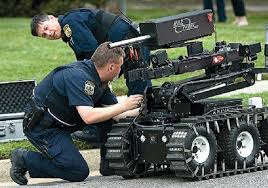
Two scenarios:
- A cyber-attack launched on government sites throws mission-critical systems into disarray and affects public safety.
- A hostage situation gets out of hand and law enforcement wants to get up close to the suspect without risking the lives of the hostages or officers.
In both scenarios, government and law enforcement organizations are looking at artificial intelligence or AI as means to solve critical issues.
AI can now be found in robots that can go into dangerous situations such as a hostage crisis or bomb scenario. In addition, the government is utilizing AI in machine learning algorithms that can detect cybercrimes – before they decimate critical systems.
Artificial Intelligence helping to Detect Cyber Risks:
Cybercriminals are becoming more technically adept at launching sophisticated attacks on government systems. This means the government – local and national – need expert security technicians to combat these outbreaks before they happen.
Government Computer News (GCN) recently quoted Edward Felten, a computer science professor at Princeton University as explaining, “…Cyber defense systems will need to respond at machine speed and find vulnerabilities. There is a huge opportunity [for AI], and it is rapidly becoming a necessity as the bad guys are adopting AI and automation in their cyber attacks.”
Machine learning, a component of AI where algorithms, learn and change automatically based on patterns in data, is becoming a critical component in detecting cyber attacks. They do this by learning what malicious behavior looks like, according to GovTech.com. “After all, if AI can learn to beat professional poker players, then why can’t it learn how digital black hats operate?”
While AI has been a critical component for preventing cyber attacks, the government is also looking to AI to improve its services – such as using intelligent “chat bots” on local and national government websites to help citizens with various functions. GovTech states, “When it comes to a customer service-type situation, AI can streamline the process by getting information from a caller while they wait for somebody to take their call.” The GSA (General Services Administration) recently launched a program for Citizen Services last year that assists agencies interested in leveraging the capabilities of tools like Amazon Alexa, IBM Watson, Microsoft Cortana and Google Assistant.
Hero Robots using AI Technology:
A robot was the hero in a recent hostage stand-off. In September of 2016, the Los Angeles County Sheriff’s Department (LASD) faced down a hostage-taker for more than six hours. The suspect became distracted by a nearby flying helicopter. As the perpetrator looked into the air, the LASD launched their Andros robot – and the robot promptly took the weapon out of the hostage taker’s hand – literally saving the day.
The use of “police robots” is becoming more common in law enforcement due to the 1997 1033 program, a program that allows for military surplus gear to be given to law enforcement agencies. Today, many agencies are using robots for “safety” reasons – not just for the officers but for civilians as well, reports Robotics Business Review. In other cases, departments like the LASD use the robots in marine situations as well as land.
The West Covina Police Department offers another example of how law enforcement is using robots. This police force within Los Angeles County has acquired 12 robots – using some of the robots for parts since not all the robots are fully functioning. In addition, the robotics team augments the department’s Special Weapons and Tactics Team with robots that can assist in searching the interior/exterior of locations, delivering equipment, and providing the ability to analyze an incident from a safe location.
Government Computer News (GCN) also reported that Endeavor, the ground-based robots produced by Endeavor Robotics, “continues to find enthusiastic users in the defense space and that demand is trickling down to local law enforcement.”
Endeavor recently released its new five-pound robots called FirstLook with improved Android-based software that allows users to move the robot more intuitively. For instance, on a tablet screen, a user only needs to “…pull their finger across the screen and point to specific areas to control the robot and drive to those areas,” stated GCN.
“The Boston police used a couple of FirstLooks after the Boston Marathon bombing to check out a couple local buildings. A lot of SWAT teams will use the FirstLook to go into a building prior to entering it themselves…” GCN reported.
While police robots are in demand, even with 1033, the funding needs for robots are considerably high – which are a barrier to entry. But as “robots” become smarter, and the technology easier to use, the demand for law enforcement is expected to rise.
Diamond IT works with local governments and law enforcement to ensure their data and networks are fully updated and properly protected. For more information on how DiamondIT can ensure your organization is using the most intelligent hardware and software, contact DiamondIT or call 877-716-8324.
